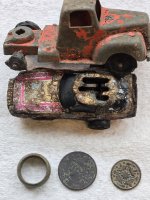Mad Machinist
Silver Member
I'm gonna start this off with saying whoever voted to close the Bureau of Mines needs some very bad things done to them where the sun don't shine.
In order to do this, one is going to have to play with a few rather nasty substances, but if the proper precautions are taken this is no different from aqua regia.
In going through amd organizing almost 25 years of notes in preparation to start mining a deposit, I found a publication put out by the now defunct Bureau of Mines. And while messing with a few pretty nasty things is necessary, a while lot of problems are solved environmentally
Flourosilicic acid, a byproduct if the fertilizer industry, will selectively dissolve lead, zinc, and the sulfur side of sulfide based ores.The other metals such as copper, silver gold, platinum metals, and rare earth metals with drop to the bottom of the tank as a "sludge" to be dealt with through other processes.
Now before anyone jumps on this screaming the grail has been found, flourosilicic acid contains a small amount of hydrofluoric acid as an impurity. Hydrofluoric acid will mess you up really bad if the proper precautions are not taken. Respiratory and body protection are required.
The lead can be recovered as a 99.94% purity with a simple electrowinning cell. Lead still has uses that are not going to disappear any time soon.
The zinc can be recovered in a closed circuit system by bubbling hydrogen sulfide through the spent electrolyte. Another nasty substance that needs.respect and proper precautions. The zinc will precipitate as zinc sulfide solid that can be recovered and sold.
The sulfide side of the ore can be recovered by a simple solvent extraction system. It will come out as elemental sulfur that is easily stored, transported, and sold for various reasons.
Flourosilicic acid spills are neutralized by the addition of lime and dilution with water. Like I said, if the proper precautions are taken it's no more dangerous than driving to your local Walmart.
Lead, zinc, amd sulfur emissions are pretty much eliminated with this.
In order to do this, one is going to have to play with a few rather nasty substances, but if the proper precautions are taken this is no different from aqua regia.
In going through amd organizing almost 25 years of notes in preparation to start mining a deposit, I found a publication put out by the now defunct Bureau of Mines. And while messing with a few pretty nasty things is necessary, a while lot of problems are solved environmentally
Flourosilicic acid, a byproduct if the fertilizer industry, will selectively dissolve lead, zinc, and the sulfur side of sulfide based ores.The other metals such as copper, silver gold, platinum metals, and rare earth metals with drop to the bottom of the tank as a "sludge" to be dealt with through other processes.
Now before anyone jumps on this screaming the grail has been found, flourosilicic acid contains a small amount of hydrofluoric acid as an impurity. Hydrofluoric acid will mess you up really bad if the proper precautions are not taken. Respiratory and body protection are required.
The lead can be recovered as a 99.94% purity with a simple electrowinning cell. Lead still has uses that are not going to disappear any time soon.
The zinc can be recovered in a closed circuit system by bubbling hydrogen sulfide through the spent electrolyte. Another nasty substance that needs.respect and proper precautions. The zinc will precipitate as zinc sulfide solid that can be recovered and sold.
The sulfide side of the ore can be recovered by a simple solvent extraction system. It will come out as elemental sulfur that is easily stored, transported, and sold for various reasons.
Flourosilicic acid spills are neutralized by the addition of lime and dilution with water. Like I said, if the proper precautions are taken it's no more dangerous than driving to your local Walmart.
Lead, zinc, amd sulfur emissions are pretty much eliminated with this.





